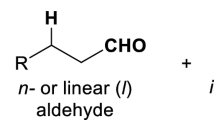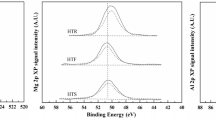Abstract
With a newly developed analytical technique, i.e. high temperature/pressure IR cell coupled to the reactor, it was possible to study the mechanism of hydroformylation at reaction conditions. It has been conclusively found that the hydrogenolysis of the acyl cobalt complex is performed by HCo(CO)4 and not by molecular H2, as proposed byHeck andBreslow.
Therefore the formation of HCo(CO)4 from Co2(CO)8 is an intermediate step in the sequence of hydroformylation reaction steps. The rate of hydroformylation of any of the olefins is smaller than the rate of formation of HCo(CO)4 from Co2(CO)8. The IR spectra reveal that always more than 30% of the cobalt is in the form of HCo(CO)4 under the reaction conditions.
It is found that the formation of HCo(CO)4 from Co2(CO)8 is the slowest and most temperature-dependent step of the hydroformylation reaction. Also the reaction between olefin and HCo(CO)4 is slower than the hydrogenolysis of the acyl complex.
The experiments were carried out under industrial oxo conditions. The diffusional effects were eliminated.
Similar content being viewed by others
References
O. Roelen (Ruhr Chemie A.G., Process for Preparing Valuable Oxo Products). (a) Ger. Pat. Appl. R. 10. 3. 362, R 402, Sept. 19, 1938. (b) Ruhr Chemie, Ger. Pat. 849,548 (1938). (c)O. Roelen, Angew. Chem.A 60, 213 (1948).
D. S. Breslow andR. F. Heck, Chem. and Ind.1960, 467.
R. F. Heck andD. S. Breslow, J. Amer. Chem. Soc.83, 4023 (1961).
L. Kirch andM. Orchin, J. Amer. Chem. Soc.81, 4200 (1959).
E. G. Hancock, Propylene and its Industrial Derivates, Ch. 9, p. 333. Ernest Benn Ltd., 1973.
Kirk-Othmer, Encyclopedia of Chemical Technology, Vol.14, 373 (1964). Wiley.
V. Yu Gankin, V. Congr. on Catal., Vol.1, 25–421 (1972).
V. Yu Gankin, V. L. Klimenko, V. A. Ribakov, andV. A. Divinin, Symp. on Hydrof., Veszprém 1972, p. 32.
V. Yu Gankin, V. A. Divinin, V. P. Novikov, V. A. Ribakov, andS. K. Skop, Kinetika i Kataliz14, 1149 (1973).
R. Whyman, J. Organometall. Chem.66, c 23-c 25(1974).
L. Markó, G. Bor, G. Almásy, andP. Szabó, Brennstoff-Chem.44, (6) 184 (1963).
E. Oltay, J. M. L. Penninger, N. H. Alemdaroğlu, andJ. M. Alberigs, Anal. Chem.45, 802 (1973).
J. Falbe, Carbon Monoxide in Organic Synthesis, p. 16. Berlin-Heidelberg-New York: Springer. 1970.
R. Iwanaga, Bull. Chem. Soc. Jap.35, 778 (1962).
G. Natta, R. Ercoli, andS. Castellano, Chim. Ind. [Milano]37, 6 (1955).
B. Silberstein, Ph.D. Dissertation, Yale Univ. 1969, 69–8435.
I. Wender, S. Metlin, S. Ergun, H. W. Sternberg, andH. Greenfield, J. Amer. Chem. Soc.78, 5401 (1956).
W. Kniese, H. J. Nienburg, andR. Fisher, J. Organometall. Chem.17, 133 (1969).
G. L. Karapinka andM. Orchin, J. Org. Chem.26, 4187 (1961).
W. Rupilius andM. Orchin, J. Org. Chem.37, 936 (1972).
J. F. Piacenti, P. Pino, R. Lazzaroni, andM. Biachi, J. Chem. Soc.C 1966, 488.
M. Orchin andW. Rupilius, Catal. Rev6 (1), 85–131 (1972).
D. A. von Bézard, G. Consiglio, andP. Pino, Chimia28, 610 (1974).
W. Rigby, R. Whyman, andK. Wilding, J. Phys. Eng. Sci., Instrum.3, 1570 (1970).
Author information
Authors and Affiliations
Additional information
With 6 Figures
Part of the Ph.D. dissertation 1974.
N. H. Alemdaroğlu, J. M. L. Penninger, andE. Oltay, Mechanism of Hydroformylation, Part II. Mh. Chem.107, 1043 (1976).
Rights and permissions
About this article
Cite this article
Alemdaroğlu, N.H., Penninger, J.L.M. & Oltay, E. Study of the mechanism of hydroformylation at industrial reaction conditions. Monatshefte für Chemie 107, 1153–1165 (1976). https://doi.org/10.1007/BF00903802
Received:
Issue Date:
DOI: https://doi.org/10.1007/BF00903802




